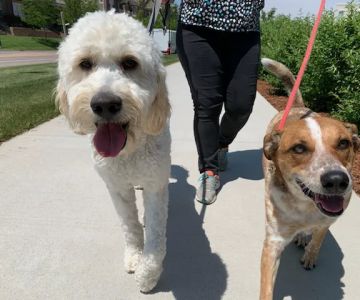The Hidden Dangers of Obesity in Pets and What You Can Do About It
As a pet owner, one of the most critical responsibilities we have is ensuring the well-being of our furry companions. We love our pets, and it’s easy to indulge them with extra treats and bigger portions, but have you ever stopped to think about the potential consequences of obesity on your pet’s health? Obesity in pets is a growing problem, and it’s not just about aesthetics—it's a serious health concern that can lead to a range of chronic conditions. Let’s explore the impact of obesity on pets, how it affects their daily lives, and what we can do to help our pets live healthier, longer lives.
1. What is Obesity in Pets?
Obesity in pets, like in humans, occurs when an animal accumulates excess fat due to an imbalance between the calories consumed and the calories expended. This often happens when pets are fed high-calorie foods, given too many treats, and don’t get enough physical exercise. According to studies, over 50% of pets in the United States are overweight or obese, and this number continues to grow year after year. The challenge is that obesity doesn’t always have immediate obvious symptoms, and we may not realize how much our pets’ health is deteriorating until it’s too late.
Obesity isn’t just about the extra weight—it’s about the extra strain it places on your pet’s body. For example, carrying excess weight can put undue stress on their joints, heart, and internal organs, increasing the likelihood of developing serious conditions such as arthritis, diabetes, high blood pressure, and even cancer.
2. The Health Risks of Obesity for Pets
It’s easy to think of obesity as merely an aesthetic issue, but the truth is that the health risks associated with it can be life-threatening. Let’s break down the key dangers:
- Joint Problems and Arthritis: Obesity is a significant contributor to joint pain and arthritis in pets, especially in older animals or breeds prone to hip dysplasia. The extra weight puts pressure on their joints, leading to inflammation, pain, and stiffness.
- Heart Disease: Just like in humans, excess weight in pets increases the risk of developing heart disease. Obese pets are more likely to suffer from high blood pressure and other cardiovascular issues that can significantly shorten their lifespan.
- Diabetes: Overweight pets are at a higher risk of developing diabetes, particularly cats and dogs who have a genetic predisposition. Diabetes can be challenging to manage and may require daily insulin injections and strict diet control.
- Respiratory Issues: Excess weight can impact a pet’s ability to breathe comfortably. They may tire more easily, experience difficulty breathing, and be less active overall, leading to further weight gain.
- Reduced Lifespan: Studies show that obese pets have a significantly shorter life expectancy compared to pets of a healthy weight. This is because obesity increases the risk of developing chronic diseases that can impact their longevity.
3. How to Identify if Your Pet is Overweight
Recognizing if your pet is overweight or obese can sometimes be tricky. Many pet owners may not realize that their pets are carrying extra pounds because they look "normal" or "healthy" on the outside. Here are a few signs to watch out for:
- Rib Test: You should be able to feel your pet’s ribs easily without too much fat covering them. If you can't feel their ribs or they’re covered with a thick layer of fat, your pet is likely overweight.
- Waistline: Look at your pet from above. A healthy pet should have a slight waistline that narrows behind the ribs. If there’s no visible waist and their body shape is more cylindrical, they may be overweight.
- Activity Levels: An overweight pet may be less active and may tire more easily during walks or play. If your pet is constantly resting or seems unwilling to move, it could be due to the strain obesity puts on their body.
- Breathing Problems: If your pet seems to have labored breathing or is panting excessively, especially after moderate exercise, it may be a sign that the extra weight is affecting their ability to breathe properly.
4. Preventing and Managing Obesity in Pets
As a pet owner, you have the power to help your pet maintain a healthy weight and avoid the dangerous health risks associated with obesity. Here are some steps you can take to prevent and manage obesity in your pet:
- Portion Control: One of the most important aspects of managing your pet’s weight is controlling their food portions. Measure out their meals instead of free-feeding or filling the bowl without thinking. You should also consider using a pet-specific food scale to ensure you're giving the right amount based on their size, age, and activity level.
- Exercise: Regular physical activity is crucial in maintaining a healthy weight for your pet. Aim for at least 30 minutes of exercise a day, whether it’s walking, playing fetch, or providing mental stimulation through puzzle toys. For some pets, exercise can be as simple as playing with their favorite toy indoors or taking them to the park.
- Healthy Diet: Feed your pet a balanced diet that’s appropriate for their age, breed, and health condition. Look for high-quality pet food that is specifically formulated to meet their nutritional needs. Avoid overfeeding treats or feeding them table scraps, as these extra calories can quickly add up.
- Regular Vet Checkups: Regular visits to the veterinarian are essential in managing your pet’s weight. Your vet can assess your pet’s body condition, provide guidance on portion sizes, and check for any underlying health conditions that may be contributing to obesity.
- Weighing Your Pet Regularly: Regularly weighing your pet allows you to keep track of their progress. If you notice they’ve gained weight, you can adjust their diet or exercise routine accordingly.
5. A Personal Story: My Experience with Managing Pet Obesity
Let me share a personal story that highlights the importance of addressing obesity in pets. My cat, Bella, was always a little on the chubby side. She loved her treats and would beg for food every time I ate. At first, I didn’t think much of it, but after a few years, Bella started to show signs of sluggishness. She wasn’t as playful as she used to be, and she started to gain weight rapidly. I took her to the vet, and it turned out that she was indeed obese. The vet advised me to cut back on her food, implement more playtime, and monitor her weight closely.
Over the next few months, I made some important changes to Bella’s routine. I switched to a more balanced diet, reduced her treats, and started playing with her daily. Slowly but surely, Bella began to lose weight, and her energy levels improved significantly. She was more active and even started climbing around the house again. Seeing Bella regain her health was incredibly rewarding, and I realized how crucial it is to address obesity early on in our pets’ lives.
6. Conclusion: Taking Action for Your Pet’s Health
As pet owners, we play a pivotal role in managing our pets’ health and well-being. Obesity in pets is a serious condition that can lead to many long-term health issues, but it’s also preventable and manageable. By being proactive about your pet’s diet, exercise routine, and overall health care, you can help them live a happier, healthier, and longer life. Remember, maintaining a healthy weight for your pet isn’t just about looking good—it’s about ensuring they have the best quality of life possible.
If you’re unsure how to manage your pet’s weight or need further advice, I highly recommend visiting a reputable veterinary clinic like Hidden Brook Veterinary, where experts can guide you in providing the best care for your pet’s unique needs.











